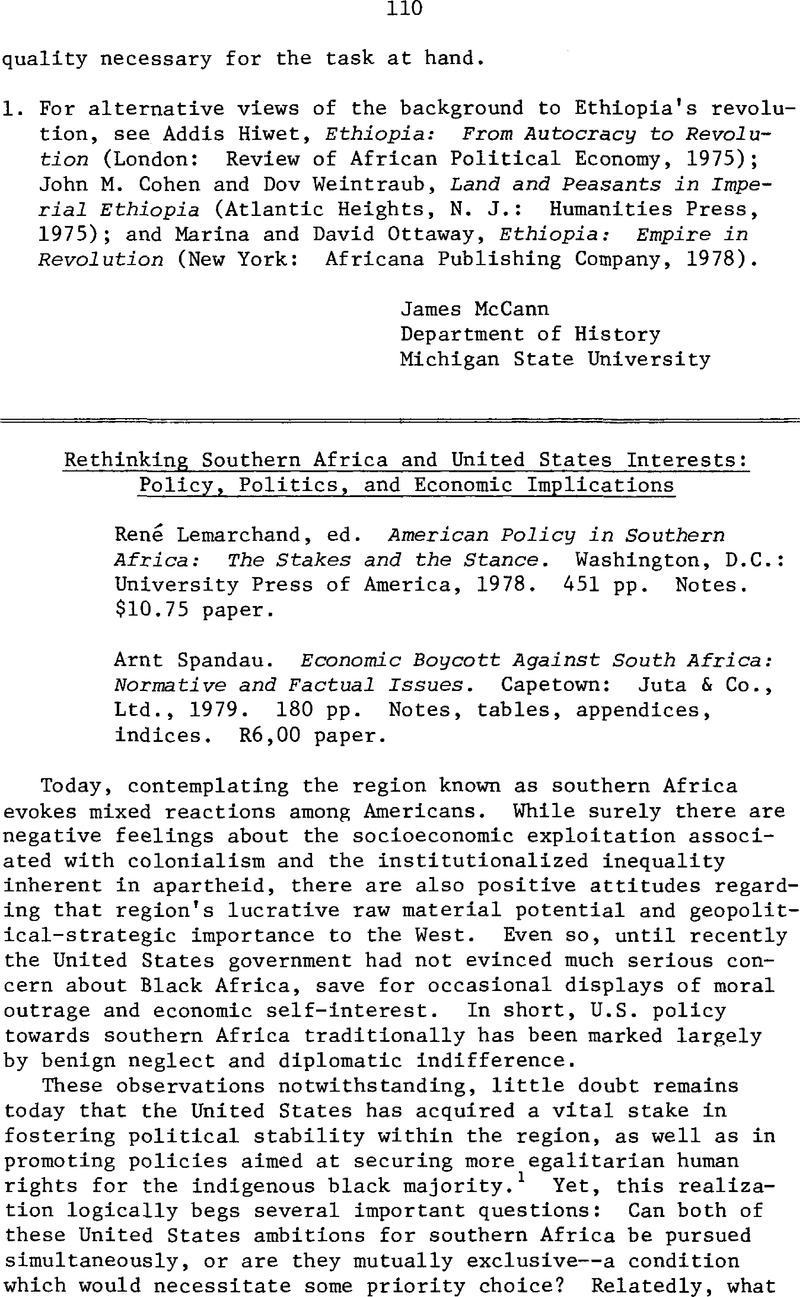No CrossRef data available.
Published online by Cambridge University Press: 23 June 2016

1. See The Advocates, Should the United States Encourage Divestment from South Africa to Promote Political Change? (Boston: WGBH, 1978)Google Scholar; Shepherd, George W. Jr., “The Struggle for a New Southern African Policy: The Carter Task,” Journal of Southern African Affairs II (Jan. 1977) 104–112 Google Scholar; U.S. Congress, Senate, Committee on Foreign Relations, U.S. Policy Toward Southern Africa, Hearings before the Subcommittee on African Affairs, 94th Cong., 1st sess., 1975; and Shepard, George W. Jr., Anti-Apartheid: Transnational Conflict and Western Policy in the Liberation of South Africa (Westport, Conn.: Greenwood Press, 1977)Google Scholar.
2. Isaacman, Allen and Davis, Jennifer, “U.S. Policy Towards Mozambique, 1946-1976: ‘The Defense of Colonialism and Regional Stability,’” in Lemarchand, René, ed., American Policy in Southern Africa: The Stakes and the Stance (Washington, D.C.: University Press of America, 1978), pp. 17–62 Google Scholar.
3. Gerald Bender, “Kissinger in Angola: Anatomy of Failure,” in ibid., pp. 63-144.
4. Nzongola-Ntalaja, “The U.S., Zaire and Angola,” in ibid., pp. 145-170.
5. Larry Bowman, “U.S. Policy Towards Rhodesia,” in ibid., pp. 171-202. For comparison, see this reviewer’s article, “The United Nations Sanctions on Rhodesia and Their Effects on Internal Political Change,” in Henry H. Han, ed., World in Transition Challenges to Human Rights, Development and World Order (Washington, D.C.: University Press of America, 1979), pp. 331-346.
6. Winston Nagan, “The U.S. and South Africa: The Limits of ‘Peaceful Change,’” in Lemarchand, op. cit., pp. 203-238.
7. William Foltz, “U.S. Policy Toward Southern Africa Economic and Strategic Constraints,” in ibid., pp. 247-274. For extensive discussion of South Africa’s mineral wealth, see Anthony Manos, “Industrial Minerals of South Africa,” Industrial Minerals, no. 122 (November 1977) 16ff.
8. The core article here is Martin Weil’s, “Can the Blacks Do for Africa What the Jews Did for Israel?” in Lemarchand, op. cit., pp. 313-322. This particular piece was originally published in Foreign Policy.
9. See the editor’s contribution, “The CIA in Africa: How Central? How Intelligent?” in Lemarchand, op. cit., pp. 341-380.
10. Namely, in the selections by Bender, Bowman, Nzongola-Ntalaja, and in Stephen Weissman’s “The CIA and U.S. Policy in Zaire and Angola,” ibid., pp. 381-432.
11. See, for example, Malan, T., “South Africa and Economic Sanctions,” Africa Institute Bulletin 18 (1978) 104ffGoogle Scholar.
12. “Andrew Young on Africa,” U.S. News & World Report 84 (June 12, 1978) 24-25; and Mehlman, Maxwell J. et al., “United States Restrictions on Exports to South Africa,” American Journal of International Law 73 (October 1979) 581–603 CrossRefGoogle Scholar.
13. For a statement of this position, see World Council of Churches, Time to Withdraw: Investments in Southern Africa (Programme to Combat Racism) (1973).
14. The population percentage is extrapolated from “Southern Africa: End of White Supremacy?” Great Decisions ’77 (New York: Foreign Policy Association, 1977), p. 17. See also Mittelman, James H., “Intervention in South Africa America’s Involvement in Apartheid,” Nation (June 9, 1979), pp. 684–689 Google Scholar.
15. It should be noted that South Africa produces in the non-communist world, 90% of its platinum; 40% of its copper; 80% of its gold, chrome, and vanadium; 60% of its diamonds; 50% of its uranium; and 75% of its manganese. In addition, a total of 46 other minerals are presently being mined in South Africa (Manos, “Industrial Minerals of South Africa,” op. cit., pp. 16-17). Also, see Ann, and Seidman, Neva, South Africa and U.S. Multinational Corporations (Westport, Conn.: Lawrence Hill and Co., 1977)Google Scholar, especially chapter six, “U.S. Investment in South African Strategic Minerals,” pp. 84-94.
16. For a thoughtful treatment of South Africa’s likely future, see Halberstam, David, “The Fire to Come in South Africa,” Atlantic Monthly 245 (May 1980) 81–95 Google Scholar.